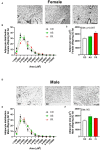Impact of Maternal Intake of Artificial Sweetener, Acesulfame-K, on Metabolic and Reproductive Health Outcomes in Male and Female Mouse Offspring
- PMID: 34938757
- PMCID: PMC8687087
- DOI: 10.3389/fnut.2021.745203
Impact of Maternal Intake of Artificial Sweetener, Acesulfame-K, on Metabolic and Reproductive Health Outcomes in Male and Female Mouse Offspring
Abstract
Guidelines advising pregnant women to avoid food and beverages with high fat and sugar have led to an increase in the consumption of "diet" options sweetened by artificial sweeteners (AS). Yet, there is limited information regarding the impact of AS intake during pregnancy on the long-term risk of cardiometabolic and reproductive complications in adult offspring. This study examined the influence of maternal acesulfame-K (Ace-K) and fructose consumption on metabolic and reproductive outcomes in offspring. Pregnant C57BL/6 mice received standard chow ad-libitum with either water (CD), fructose (Fr; 20% kcal intake), or AS (AS; 12.5 mM Ace-K) throughout pregnancy and lactation (n = 8/group). Postweaning offspring were maintained on a CD diet for the remainder of the experiment. Body weight, food intake, and water intake were measured weekly. Oral glucose tolerance tests (OGTT) were undertaken at 12 weeks, and the offspring were culled at week 14. Female, but not male, AS groups exhibited decreased glucose tolerance compared to Fr. There was an increase in gonadal fat adipocyte size in male offspring from AS and Fr groups compared to CD groups. In female offspring, adipocyte size was increased in the Fr group compared to the CD group. In female, but not male offspring, there was a trend toward increase in Fasn gene expression in AS group compared to the CD group. Maternal AS and Fr also negatively impacted upon female offspring estrus cycles and induced alterations to markers associated with ovulation. In summary, exposure to Ace-k via the maternal diet leads to impaired glucose tolerance and impacts adipocyte size in a sex-specific manner as well as significantly affecting estrus cycles and related gene markers in female offspring. This has implications in terms of providing tailored dietary advice for pregnant women and highlights the potential negative influence of artificial sweetener intake in the context of intergenerational impacts.
Keywords: adipose tissue; artificial sweetener; maternal nutrition; metabolic health; reproductive.
Copyright © 2021 Bridge-Comer, Vickers, Morton-Jones, Spada, Rong and Reynolds.
Conflict of interest statement
The authors declare that the research was conducted in the absence of any commercial or financial relationships that could be construed as a potential conflict of interest.
Figures






References
LinkOut - more resources
Full Text Sources
Research Materials
Miscellaneous

